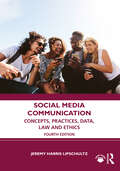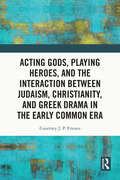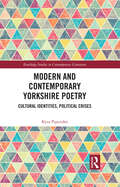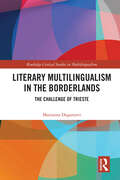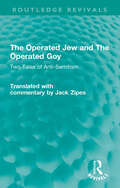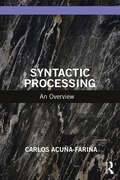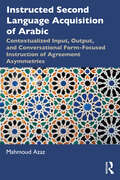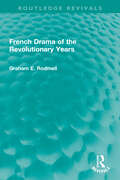- Table View
- List View
New Psychoanalytic Readings of Shakespeare: Cool Reason and Seething Brains (Routledge Studies in Shakespeare)
by James Newlin James W. StoneIt has been over two decades since the publication of the last major edited collection focused on psychoanalysis and early modern culture. In Shakespeare studies, the New Historicism and cognitive psychology have hindered a dynamic conversation engaging depth-oriented models of the mind from taking place. The essays in New Psychoanalytic Readings of Shakespeare: Cool Reason and Seething Brains seek to redress this situation, by engaging a broad spectrum of psychoanalytic theory and criticism, from Freud to the present, to read individual plays closely. These essays show how psychoanalytic theory helps us to rethink the plays’ history of performance; their treatment of gender, sexuality, and race; their view of history and trauma; and the ways in which they anticipate contemporary psychodynamic treatment. Far from simply calling for a conventional "return to Freud," the essays collected here initiate an exciting conversation between Shakespeare studies and psychoanalysis in the hopes of radically transforming both disciplines. It is time to listen, once again, to seething brains.
**Missing**: Doomsday Clock Narratives (Routledge Studies in World Literatures and the Environment)
by Dominika Oramus(Eco)Anxiety in Nuclear Holocaust Fiction and Climate Fiction: Doomsday Clock Narratives demonstrates that disaster fiction— nuclear holocaust and climate change alike— allows us to unearth and anatomise contemporary psychodynamics and enables us to identify pretraumatic stress as the common denominator of seemingly unrelated types of texts. These Doomsday Clock Narratives argue that earth’s demise is soon and certain. They are set after some catastrophe and depict people waiting for an even worse catastrophe to come. References to geology are particularly important— in descriptions of the landscape, the emphasis falls on waste and industrial bric- a- brac, which is seen through the eyes of a future, posthuman archaeologist. Their protagonists have the uncanny feeling that the countdown has already started, and they are coping with both traumatic memories and pretraumatic stress. Readings of novels by Walter M. Miller, Nevil Shute, John Christopher, J. G. Ballard, George Turner, Maggie Gee, Paolo Bacigalupi, Ruth Ozeki, and Yoko Tawada demonstrate that the authors are both indebted to a century- old tradition and inventively looking for new ways of expressing the pretraumatic stress syndrome common in contemporary society. This book is written for an academic audience (postgraduates, researchers, and academics) specialising in British Literature, American Literature, and Science Fiction Studies.
New Psychoanalytic Readings of Shakespeare: Cool Reason and Seething Brains (Routledge Studies in Shakespeare)
by James Newlin and James W. StoneIt has been over two decades since the publication of the last major edited collection focused on psychoanalysis and early modern culture. In Shakespeare studies, the New Historicism and cognitive psychology have hindered a dynamic conversation engaging depth-oriented models of the mind from taking place. The essays in New Psychoanalytic Readings of Shakespeare: Cool Reason and Seething Brains seek to redress this situation, by engaging a broad spectrum of psychoanalytic theory and criticism, from Freud to the present, to read individual plays closely. These essays show how psychoanalytic theory helps us to rethink the plays’ history of performance; their treatment of gender, sexuality, and race; their view of history and trauma; and the ways in which they anticipate contemporary psychodynamic treatment. Far from simply calling for a conventional "return to Freud," the essays collected here initiate an exciting conversation between Shakespeare studies and psychoanalysis in the hopes of radically transforming both disciplines. It is time to listen, once again, to seething brains.
**Missing**: Doomsday Clock Narratives (Routledge Studies in World Literatures and the Environment)
by Dominika Oramus(Eco)Anxiety in Nuclear Holocaust Fiction and Climate Fiction: Doomsday Clock Narratives demonstrates that disaster fiction— nuclear holocaust and climate change alike— allows us to unearth and anatomise contemporary psychodynamics and enables us to identify pretraumatic stress as the common denominator of seemingly unrelated types of texts. These Doomsday Clock Narratives argue that earth’s demise is soon and certain. They are set after some catastrophe and depict people waiting for an even worse catastrophe to come. References to geology are particularly important— in descriptions of the landscape, the emphasis falls on waste and industrial bric- a- brac, which is seen through the eyes of a future, posthuman archaeologist. Their protagonists have the uncanny feeling that the countdown has already started, and they are coping with both traumatic memories and pretraumatic stress. Readings of novels by Walter M. Miller, Nevil Shute, John Christopher, J. G. Ballard, George Turner, Maggie Gee, Paolo Bacigalupi, Ruth Ozeki, and Yoko Tawada demonstrate that the authors are both indebted to a century- old tradition and inventively looking for new ways of expressing the pretraumatic stress syndrome common in contemporary society. This book is written for an academic audience (postgraduates, researchers, and academics) specialising in British Literature, American Literature, and Science Fiction Studies.
Social Media Communication: Concepts, Practices, Data, Law and Ethics
by Jeremy Harris LipschultzThis updated fourth edition presents a wide-scale, interdisciplinary guide to social media communication. Examining platforms like Facebook, Instagram, Snapchat, TikTok, Twitter and YouTube, the book analyzes social media's use in journalism, public relations, advertising and marketing. Lipschultz focuses on key concepts, best practices, data analyses, law and ethics – all promoting the critical thinking that is needed to use new, evolving and maturing networking tools effectively within social and mobile media spaces. Featuring historical markers and contemporary case studies, essays from some of the industry’s leading social media innovators and a comprehensive glossary, this practical, multipurpose textbook gives readers the resources they will need to both evaluate and utilize current and future forms of social media communication. Updates to the fourth edition include expanded discussion of disinformation, the impact of artificial intelligence (AI), natural language chatbots, virtual and augmented reality technologies and the COVID-19 infodemic. Social Media Communication is the perfect social media primer for students and professionals and, with a dedicated online teaching guide, ideal for instructors, too.
Social Media Communication: Concepts, Practices, Data, Law and Ethics
by Jeremy Harris LipschultzThis updated fourth edition presents a wide-scale, interdisciplinary guide to social media communication. Examining platforms like Facebook, Instagram, Snapchat, TikTok, Twitter and YouTube, the book analyzes social media's use in journalism, public relations, advertising and marketing. Lipschultz focuses on key concepts, best practices, data analyses, law and ethics – all promoting the critical thinking that is needed to use new, evolving and maturing networking tools effectively within social and mobile media spaces. Featuring historical markers and contemporary case studies, essays from some of the industry’s leading social media innovators and a comprehensive glossary, this practical, multipurpose textbook gives readers the resources they will need to both evaluate and utilize current and future forms of social media communication. Updates to the fourth edition include expanded discussion of disinformation, the impact of artificial intelligence (AI), natural language chatbots, virtual and augmented reality technologies and the COVID-19 infodemic. Social Media Communication is the perfect social media primer for students and professionals and, with a dedicated online teaching guide, ideal for instructors, too.
Acting Gods, Playing Heroes, and the Interaction between Judaism, Christianity, and Greek Drama in the Early Common Era
by Courtney J. FriesenWhile many ancient Jewish and Christian leaders voiced opposition to Greek and Roman theater, this volume demonstrates that by the time the public performance of classical drama ceased at the end of antiquity the ideals of Jews and Christians had already been shaped by it in profound and lasting ways. Readers are invited to explore how gods and heroes famous from Greek drama animated the imaginations of ancient individuals and communities as they articulated and reinvented their religious visions for a new era. In this study, Friesen demonstrates that Greek theater’s influence is evident within Jewish and Christian intellectual formulations, narrative constructions, and practices of ritual and liturgy. Through a series of interrelated case studies, the book examines how particular plays, through texts and performances, scenes, images, and heroic personae, retained appeal for Jewish and Christian communities across antiquity. The volume takes an interdisciplinary approach involving classical, Jewish, and Christian studies, and brings together these separate avenues of scholarship to produce fresh insights and a reevaluation of theatrical drama in relation to ancient Judaism and Christianity. Acting Gods, Playing Heroes, and the Interaction between Judaism, Christianity, and Greek Drama in the Early Common Era allows students and scholars of the diverse and evolving religious landscapes of antiquity to gain fresh perspectives on the interplay between the gods and heroes—both human and divine—of Greeks and Romans, Jews and Christians as they were staged in drama and depicted in literature.
Acting Gods, Playing Heroes, and the Interaction between Judaism, Christianity, and Greek Drama in the Early Common Era
by Courtney J. FriesenWhile many ancient Jewish and Christian leaders voiced opposition to Greek and Roman theater, this volume demonstrates that by the time the public performance of classical drama ceased at the end of antiquity the ideals of Jews and Christians had already been shaped by it in profound and lasting ways. Readers are invited to explore how gods and heroes famous from Greek drama animated the imaginations of ancient individuals and communities as they articulated and reinvented their religious visions for a new era. In this study, Friesen demonstrates that Greek theater’s influence is evident within Jewish and Christian intellectual formulations, narrative constructions, and practices of ritual and liturgy. Through a series of interrelated case studies, the book examines how particular plays, through texts and performances, scenes, images, and heroic personae, retained appeal for Jewish and Christian communities across antiquity. The volume takes an interdisciplinary approach involving classical, Jewish, and Christian studies, and brings together these separate avenues of scholarship to produce fresh insights and a reevaluation of theatrical drama in relation to ancient Judaism and Christianity. Acting Gods, Playing Heroes, and the Interaction between Judaism, Christianity, and Greek Drama in the Early Common Era allows students and scholars of the diverse and evolving religious landscapes of antiquity to gain fresh perspectives on the interplay between the gods and heroes—both human and divine—of Greeks and Romans, Jews and Christians as they were staged in drama and depicted in literature.
Modern and Contemporary Yorkshire Poetry: Cultural Identities, Political Crises (Routledge Studies in Contemporary Literature)
by Kyra PiperidesDelving into the landscapes and politics of twentieth- and twenty-first-century South, East, and West Yorkshire, Modern and Contemporary Yorkshire Poetry: Cultural Identities, Political Crises theorises Yorkshire as a distinct region of poetry in its own right. In outlining the commonalities and parameters of this branch of poetry, Modern and Contemporary Yorkshire Poetry engages the work with a selection of poets writing in and about the region since 1945, including Philip Larkin, Ted Hughes, Simon Armitage, Helen Mort, Zaffar Kunial, Kate Fox, and Vicky Foster. Charting the developments in Yorkshire poetry, this book explores several key contexts – including deindustrialisation, the Miners’ Strikes, and Brexit – in detail, evidencing the impacts of these sociopolitical events on the poetry of a region. Modern and Contemporary Yorkshire Poetry investigates 75 years of poetry to ask the question: what is Yorkshire poetry? In other words, what is it that connects poems by these writers, whilst setting them apart from poetry of other UK regions?
Modern and Contemporary Yorkshire Poetry: Cultural Identities, Political Crises (Routledge Studies in Contemporary Literature)
by Kyra PiperidesDelving into the landscapes and politics of twentieth- and twenty-first-century South, East, and West Yorkshire, Modern and Contemporary Yorkshire Poetry: Cultural Identities, Political Crises theorises Yorkshire as a distinct region of poetry in its own right. In outlining the commonalities and parameters of this branch of poetry, Modern and Contemporary Yorkshire Poetry engages the work with a selection of poets writing in and about the region since 1945, including Philip Larkin, Ted Hughes, Simon Armitage, Helen Mort, Zaffar Kunial, Kate Fox, and Vicky Foster. Charting the developments in Yorkshire poetry, this book explores several key contexts – including deindustrialisation, the Miners’ Strikes, and Brexit – in detail, evidencing the impacts of these sociopolitical events on the poetry of a region. Modern and Contemporary Yorkshire Poetry investigates 75 years of poetry to ask the question: what is Yorkshire poetry? In other words, what is it that connects poems by these writers, whilst setting them apart from poetry of other UK regions?
Literary Multilingualism in the Borderlands: The Challenge of Trieste (ISSN)
by Marianna DeganuttiThis book focuses on literary multilingualism and specifically on the challenging condition of writing in Trieste, a key European borderland located at the intersection between the Latin, Germanic and Slav civilisations.By focusing on some of the most representative modern writers operating in the area, such as Italo Svevo, Boris Pahor, Claudio Magris and James Joyce, this work offers a wide-ranging discussion of multilingual practices deriving from the different language choices made by these writers. Along with the most common manifest strategies, such as code-switching and hybridisations, Deganutti highlights how Triestine writers found innovative latent practices to engage with multilingualism, such as writing in an analogical way or exploiting internal linguistic stratifications. Moreover, she shows how they provided answers to the several linguistic, cultural and even political challenges they were subjected to, with the result of redefining linguistic boundaries that clearly separate different tongues.This book will be of interest to graduate students, researchers and academics interested in literary multilingualism in the fields of sociolinguistics, borderland studies and comparative literature.
The Operated Jew and The Operated Goy: Two Tales of Anti-Semitism (Routledge Revivals)
Originally published in English in 1991 and now reissued with a new Preface by Jack Zipes, this book presents and examines the work of two little-known writers, Oskar Panizza and Mynona (Salomo Friedlaender). In Panizza’s chilling story, The Operated Jew (1893), a turn-of-the- century Jew undergoes a series of disfiguring operations that transform him into a ‘European’. The tale mingles loathing with compassion for its title character. Thirty years later, Panizza’s tale was answered by Mynona, an urbane German Jew who turned the story’s tables in The Operated Goy (1922). In his introduction and essays, Jack Zipes explores some of the myths of modern anti-Semitic thought. He also examines parallels between the rise of anti-Semitism in Europe and the violence of Arabs and Israelis in the Middle East, issues which have an enduring relevance and are as pertinent in the 21st Century as when the book was first published.
Literary Multilingualism in the Borderlands: The Challenge of Trieste (ISSN)
by Marianna DeganuttiThis book focuses on literary multilingualism and specifically on the challenging condition of writing in Trieste, a key European borderland located at the intersection between the Latin, Germanic and Slav civilisations.By focusing on some of the most representative modern writers operating in the area, such as Italo Svevo, Boris Pahor, Claudio Magris and James Joyce, this work offers a wide-ranging discussion of multilingual practices deriving from the different language choices made by these writers. Along with the most common manifest strategies, such as code-switching and hybridisations, Deganutti highlights how Triestine writers found innovative latent practices to engage with multilingualism, such as writing in an analogical way or exploiting internal linguistic stratifications. Moreover, she shows how they provided answers to the several linguistic, cultural and even political challenges they were subjected to, with the result of redefining linguistic boundaries that clearly separate different tongues.This book will be of interest to graduate students, researchers and academics interested in literary multilingualism in the fields of sociolinguistics, borderland studies and comparative literature.
The Operated Jew and The Operated Goy: Two Tales of Anti-Semitism (Routledge Revivals)
by Jack ZipesOriginally published in English in 1991 and now reissued with a new Preface by Jack Zipes, this book presents and examines the work of two little-known writers, Oskar Panizza and Mynona (Salomo Friedlaender). In Panizza’s chilling story, The Operated Jew (1893), a turn-of-the- century Jew undergoes a series of disfiguring operations that transform him into a ‘European’. The tale mingles loathing with compassion for its title character. Thirty years later, Panizza’s tale was answered by Mynona, an urbane German Jew who turned the story’s tables in The Operated Goy (1922). In his introduction and essays, Jack Zipes explores some of the myths of modern anti-Semitic thought. He also examines parallels between the rise of anti-Semitism in Europe and the violence of Arabs and Israelis in the Middle East, issues which have an enduring relevance and are as pertinent in the 21st Century as when the book was first published.
Syntactic Processing: An Overview
by Carlos Acuña-FariñaThis book provides an overview of the structures, topics and main theories of syntactic processing. It covers the last 40 years of sentence-level psycholinguistic research and debates and makes it accessible to both theoretical linguists and experimental psychologists. Tying linguistically relevant issues to psycholinguistic theory, this book: Covers the processing of the grammatical phenomena adjunction, agreement and gap filling and discusses the relationship between grammars and parsers Discusses experimental work and theories, demonstrating how psychologists have made real strides in understanding language and how studying the processing of syntactic structure is the same as studying the nature of language Explores the key theories of psycholinguistics, including recent developments Explains the different methodologies of sentence processing, such as eye-tracking and electroencephalography Bridging the gap between psycholinguistic research and the study of language, this book is essential reading for advanced students and scholars of linguistics and experimental psycholinguistics as well as cognitive science and psychology.
Syntactic Processing: An Overview
by Carlos Acuña-FariñaThis book provides an overview of the structures, topics and main theories of syntactic processing. It covers the last 40 years of sentence-level psycholinguistic research and debates and makes it accessible to both theoretical linguists and experimental psychologists. Tying linguistically relevant issues to psycholinguistic theory, this book: Covers the processing of the grammatical phenomena adjunction, agreement and gap filling and discusses the relationship between grammars and parsers Discusses experimental work and theories, demonstrating how psychologists have made real strides in understanding language and how studying the processing of syntactic structure is the same as studying the nature of language Explores the key theories of psycholinguistics, including recent developments Explains the different methodologies of sentence processing, such as eye-tracking and electroencephalography Bridging the gap between psycholinguistic research and the study of language, this book is essential reading for advanced students and scholars of linguistics and experimental psycholinguistics as well as cognitive science and psychology.
Medieval Teachers of Freedom: Boethius, Peter Lombard and Aquinas on Creation from Nothing (Anglo-Italian Renaissance Studies)
by Marco Antonio AndreacchioMedieval debates over "divine creation" are systematically obscured in our age by the conflict between "Intelligent Design" Creationists and Evolutionists. The present investigation cuts through the web of contemporary conflicts to examine problems seated at the heart of medieval talk about creation. From three representative authors we learn that the doctrine of divine creation is supposed to invite understanding of the relation between artistic freedom and natural necessity, of the very essence of causality, and thereby of the nexus between experience (our world of empirical determinations) and reality (the absolute indetermination of eternal being). Most importantly, medieval scholarship shows us that the problems it addresses are originally inherent in the understanding itself, whereby the question of being emerges as inseparable from the question of interpretation.
Medieval Teachers of Freedom: Boethius, Peter Lombard and Aquinas on Creation from Nothing (Anglo-Italian Renaissance Studies)
by Marco Antonio AndreacchioMedieval debates over "divine creation" are systematically obscured in our age by the conflict between "Intelligent Design" Creationists and Evolutionists. The present investigation cuts through the web of contemporary conflicts to examine problems seated at the heart of medieval talk about creation. From three representative authors we learn that the doctrine of divine creation is supposed to invite understanding of the relation between artistic freedom and natural necessity, of the very essence of causality, and thereby of the nexus between experience (our world of empirical determinations) and reality (the absolute indetermination of eternal being). Most importantly, medieval scholarship shows us that the problems it addresses are originally inherent in the understanding itself, whereby the question of being emerges as inseparable from the question of interpretation.
Instructed Second Language Acquisition of Arabic: Contextualized Input, Output, and Conversational Form-Focused Instruction of Agreement Asymmetries
by Mahmoud AzazInstructed Second Language Acquisition of Arabic examines the acquisition of agreement asymmetries in the grammatical system of Arabic as a second/foreign language through the lens of instructed second language acquisition. The book explores how to improve the processes of L2 learning of Arabic using evidence-based classroom research. Before it does this, it characterizes the variable challenges that English L2 learners of Arabic face when they acquire four structural cases in Arabic grammar that entail agreement asymmetries. Using the pretest–posttest design, it examines the effects of four classroom interventions using quantitative and qualitative measures. In these interventions, form-based and meaning-based measures were used to reveal to what degree learners have developed explicit and implicit knowledge of these aspects of asymmetry. In the concluding chapter, the book provides focused and specific implications based on the results of the four studies. It provides theoretical implications that enrich the discussions of instructed second language Acquisition in Arabic and other languages more broadly. It also provides implications for teachers, curriculum designers, and textbook writers of Arabic. This book will be informative for Arabic applied linguists, researchers of Arabic SLA, Arabic instructors (at the K–12 and the college level), and Arabic program directors and coordinators. The book will also appeal to all SLA and ISLA researchers.
The Allegory of Love in the Early Renaissance: Francesco Colonna’s Hypnerotomachia Poliphili and its European Context (Anglo-Italian Renaissance Studies)
by James Calum O’NeillDescribed as ‘the most beautiful book ever printed’ previous research has focused on the printing history of the Hypnerotomachia and its copious literary sources. This monograph critically engages with the narrative of the Hypnerotomachia and with Poliphilo as a character within this narrative, placing it within its European literary context. Using narratological analysis, it examines the journey of Poliphilo and the series of symbolic, allegorical, and metaphorical experiences narrated by him that are indicative of his metamorphosing interiority. It analyses the relationship between Poliphilo and his external surroundings in sequences of the narrative pertaining to thresholds; the symbolic architectural, topographical, and garden forms and spaces; and Poliphilo’s transforming interior passions including his love of antiquarianism, language, and Polia, the latter of which leads to his elegiac description of lovesickness, besides examinations of numerosophical symbolism in number, form, and proportion of the architectural descriptions and how they relate to the narrative.
French Drama of the Revolutionary Years (Routledge Revivals)
by Graham E. RodmellFrench Drama of the Revolutionary Years (1990) examines the years following the Revolution which saw an explosion both in the number of theatres and in the number of dramatic representations written and performed. It describes this turbulent period of theatre history, placing it firmly within the context of French social and political life, and illustrating the discussion with examinations of contemporary texts. It focuses on the political and philosophical themes of the plays, and the light they throw on events of the time.
English Literature and Ideas in the Twentieth Century: An Inquiry into Present Difficulties and Future Prospects (Routledge Revivals)
by H.V. RouthEnglish Literature and Ideas in the Twentieth Century (1950) looks at the British pioneers of a new style of writing in the twentieth century. Handling new material in new ways, their experiments in technique and presentation are examined by the light of what was passing in their minds, and in the minds of their readers – attitudes, aspirations and dreams which are sometimes uncongenial, always unconventional.
Instructed Second Language Acquisition of Arabic: Contextualized Input, Output, and Conversational Form-Focused Instruction of Agreement Asymmetries
by Mahmoud AzazInstructed Second Language Acquisition of Arabic examines the acquisition of agreement asymmetries in the grammatical system of Arabic as a second/foreign language through the lens of instructed second language acquisition. The book explores how to improve the processes of L2 learning of Arabic using evidence-based classroom research. Before it does this, it characterizes the variable challenges that English L2 learners of Arabic face when they acquire four structural cases in Arabic grammar that entail agreement asymmetries. Using the pretest–posttest design, it examines the effects of four classroom interventions using quantitative and qualitative measures. In these interventions, form-based and meaning-based measures were used to reveal to what degree learners have developed explicit and implicit knowledge of these aspects of asymmetry. In the concluding chapter, the book provides focused and specific implications based on the results of the four studies. It provides theoretical implications that enrich the discussions of instructed second language Acquisition in Arabic and other languages more broadly. It also provides implications for teachers, curriculum designers, and textbook writers of Arabic. This book will be informative for Arabic applied linguists, researchers of Arabic SLA, Arabic instructors (at the K–12 and the college level), and Arabic program directors and coordinators. The book will also appeal to all SLA and ISLA researchers.
The Allegory of Love in the Early Renaissance: Francesco Colonna’s Hypnerotomachia Poliphili and its European Context (Anglo-Italian Renaissance Studies)
by James Calum O’NeillDescribed as ‘the most beautiful book ever printed’ previous research has focused on the printing history of the Hypnerotomachia and its copious literary sources. This monograph critically engages with the narrative of the Hypnerotomachia and with Poliphilo as a character within this narrative, placing it within its European literary context. Using narratological analysis, it examines the journey of Poliphilo and the series of symbolic, allegorical, and metaphorical experiences narrated by him that are indicative of his metamorphosing interiority. It analyses the relationship between Poliphilo and his external surroundings in sequences of the narrative pertaining to thresholds; the symbolic architectural, topographical, and garden forms and spaces; and Poliphilo’s transforming interior passions including his love of antiquarianism, language, and Polia, the latter of which leads to his elegiac description of lovesickness, besides examinations of numerosophical symbolism in number, form, and proportion of the architectural descriptions and how they relate to the narrative.
French Drama of the Revolutionary Years (Routledge Revivals)
by Graham E. RodmellFrench Drama of the Revolutionary Years (1990) examines the years following the Revolution which saw an explosion both in the number of theatres and in the number of dramatic representations written and performed. It describes this turbulent period of theatre history, placing it firmly within the context of French social and political life, and illustrating the discussion with examinations of contemporary texts. It focuses on the political and philosophical themes of the plays, and the light they throw on events of the time.


